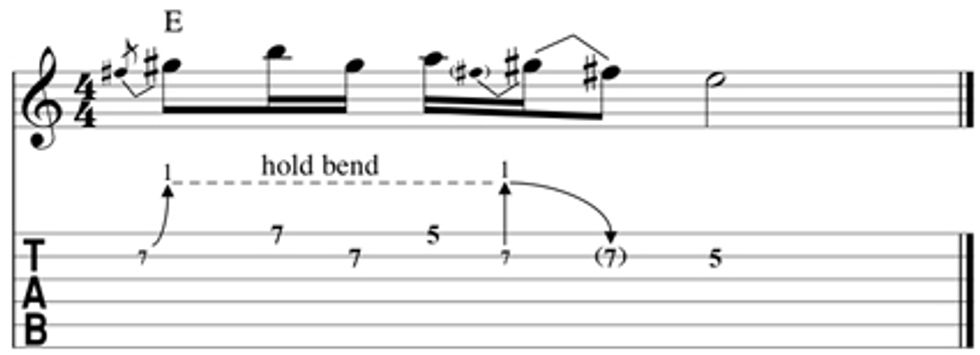Chops: Intermediate
Theory: Intermediate
Lesson Overview:
• Create steel guitar-inspired phrases with unison and oblique bends.
• Play greasy double-stop licks by bending two notes at the same time.
• Learn the secrets behind the licks of James Burton and Albert Lee.
I love the pedal steel, but I am entirely too lazy to sit down behind one and learn all those crazy tunings. I have enough of a problem with standard tuning, so C6 is out of my realm of comprehension. So, like many jealous guitar players, I’ve tried to cop as many of those sweet country-infused sounds as I can and insert them into non-country styles of music-like the blues, for example. Here are some cool, yet fairly easy licks to get you started on the road to Twang Town Blues.
The lick in Fig. 1 is a standard steel lick that will get your foot in the door. Actually, I think I heard a similar phrase on “Hot Legs” by Rod Stewart when I was a kid. It’s also a Southern rock staple that works great on an E or E7 chord. Why you may ask? Well, because by bending the F# on the 11th fret up a whole-step to G# and sustaining the B and E on the 12th fret, we go from an Esus2 chord to an E triad. Sweet.
We get a bit more of the country sound from Fig. 2. Once again, we’re bending the second degree of the scale to the third, but what makes this one a little trickier is changing the top note while holding the G# bend. Make sure you keep that bend in tune! Out-of-tune notes hurt my fillings.
We add some double-stops in Fig. 3. This will take a bit of work, but the goal is to bend two strings up a half-step and keep things in tune. In this case, it is the %3 and %5 being bent up a half-step. Tricky. Okay, very tricky since the tension is not the same on both strings. The pitches will inevitably be slightly out of tune, so to remedy this, add some vibrato. Fortunately, the aural rub of slightly out- of-tune notes actually adds to the character and greasy sound that we want. This is definitely a guitar-face lick.
Let’s apply the same idea to an ascending lick. As with all the other examples, it’s essential to keep the bends in Fig. 4 in tune. This is another one over an E7 chord. I really like the rub the bent and fretted notes produce. Play the lick slowly, so you can really hear those overtones fighting with each other. I love that sound.
In Fig. 5, we push the technique a little more for a lick that will make you want to buy a 10-gallon hat. Essentially, we are repeating the phrase that occurs over the first two beats again on the next group of strings. Keep those bent notes in tune and add a little snap to your attack to really pull everything out of this lick.
Finally, Fig. 6 is the one I find the most difficult to master. The tough part is pull- ing the G string down toward the floor while keeping the fretted lower notes stable. Keep at it and you’ll get it, and if you are anything like me, you’ll use it all the time.
There are many players who are masters of steel-inspired bending—Jimmy Bryant, James Burton, Albert Lee, and Danny Gatton, to name a few. One of my favorite players, David Grissom, does an amazing job of integrating this technique into rootsy blues-rock. If you are not familiar with some of these names, make sure to check them out on the interwebs.
 Jeff McErlain
Jeff McErlainJeff McErlain is a New York City-based guitar player, producer, songwriter, and educator. He performs regularly in NYC and abroad with his trio and blues band. Jeff has a number of instructional DVDs available at TrueFire.com, and he is a featured instructor for the National Guitar Workshop. Jeff's latest CD I'm Tired is available on iTunes or at jeffmcerlain.com.

















![Rig Rundown: Russian Circles’ Mike Sullivan [2025]](https://www.premierguitar.com/media-library/youtube.jpg?id=62303631&width=1245&height=700&quality=70&coordinates=0%2C0%2C0%2C0)





